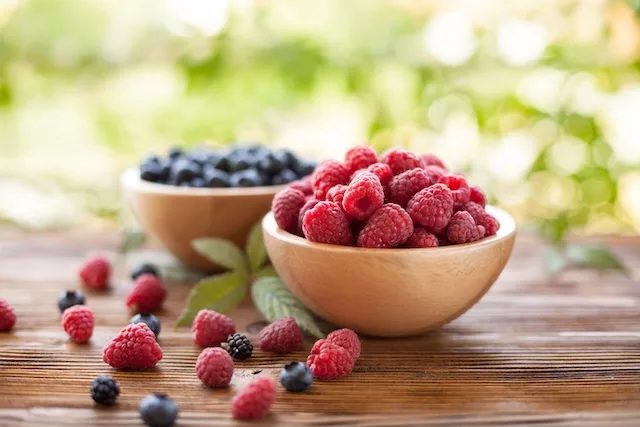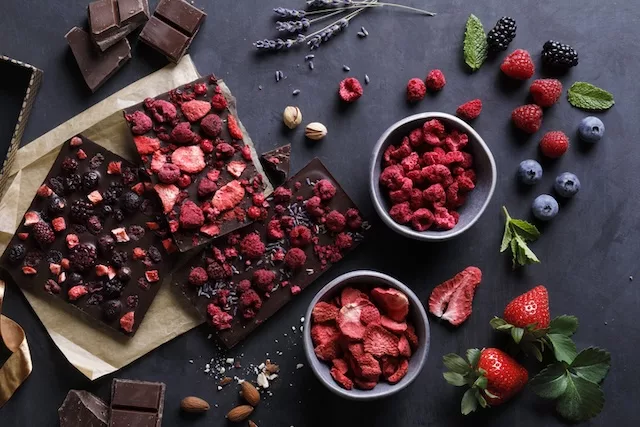Fiber is a powerhouse nutrient essential for overall health, yet many don’t get enough. From supporting digestion and gut health to promoting satiety, fiber plays a key role in how we feel daily. But how much fiber do you need, and how can you hit those daily goals? This guide will break it all down—including how HUM Nutrition’s new GLP1 Fiber Powder can help you easily meet your fiber needs.


How Much Fiber Per Day Is Recommended?
According to the USDA, adults should aim for the following daily fiber intake:
- Men: ~38 grams per day
- Women: ~25 grams per day
Despite these recommendations, the average American only consumes around 15 grams of fiber daily—less than half of what’s needed. This gap is largely due to diets low in fruits, vegetables, whole grains, and legumes and high in processed foods.
To visualize what meeting your fiber goals looks like, here’s a breakdown:
- 1 medium apple: ~4 grams
- 1 cup of cooked broccoli: ~5 grams
- 1 slice of whole-grain bread: ~2 grams
- 1 cup of cooked lentils: ~15 grams
- 2 tablespoons of chia seeds: ~10 grams
Adding these foods together already puts women close to their daily target of 25 grams and gives men a strong foundation to build on.
However, not all fiber is created equal. Remember, fiber comes in two types, and balancing both is key.
- Soluble Fiber: Found in oats, beans, apples, chia, and flax seeds. It forms a gel-like substance in your digestive system to support bowel regularity. Also, it can help slow the absorption of sugar in your body (hello balanced blood sugar), as well as help to act as a broom to sweep, bind, and excrete excess cholesterol in the body. To help you visualize this, a great example is the viral chia seed water trend, thinking about the chia seeds expanding in water and sometimes clumping together.
- Insoluble Fiber: Found in whole grains, nuts like almonds, fruit like raspberries, and vegetables like carrots and brussels sprouts. This type adds bulk to stool, promoting regularity and preventing constipation.
As a Dietitian, I encourage finding a happy mix of soluble and insoluble fiber. However, if you’re a fiber newbie, I encourage you to focus on soluble fiber, as it can be a bit gentler.
For an even simpler solution, consider using HUM’s GLP1 Fiber Powder to effortlessly boost your intake. Read more about our new fantastic formula, which we know you’ll love, below!
Why Is Getting Enough Fiber Per Day Important?
Many people may think of fiber as beneficial for your gut health, and while that’s true, its benefits extend past the walls of the digestive tract. Let’s break down why hitting your daily fiber goals matters to your gut and the rest of your body!
1. Improved Digestion and Bowel Regularity
Fiber helps keep your digestive system running smoothly. Insoluble fiber adds bulk to stool, making it easier to pass, while soluble fiber helps soften it. Together, they reduce the risk of constipation and keep you feeling light and regular. For women, this can also mean less bloating and discomfort.
2. Supports a Healthy Gut Microbiome
Your gut is home to trillions of bacteria that play a key role in digestion, immunity, and even mood. Fiber acts as a prebiotic, feeding the good bacteria in your gut and helping them thrive. A well-fed microbiome can lead to better nutrient absorption, a stronger immune system, and fewer digestive woes. Plus, a healthy gut microbiome also supports a healthy complexion and mood.
3. Helps With Blood Sugar Management
Fiber, especially soluble fiber, slows the absorption of sugar into your bloodstream, preventing those dreaded energy crashes. For women, this can be particularly beneficial for managing blood sugar fluctuations during different phases of the menstrual cycle or menopause, as blood sugar is thought to play a role in hormonal imbalances like PCOS. Not to mention, chronically high blood sugar often plays a role in weight gain, and imbalances in blood sugar often impact our mood (thinking irritability and low energy).
4. Promotes Heart Health
Soluble fiber binds to cholesterol in the digestive system, helping to remove it from the body. This process supports healthy cholesterol levels and may reduce the risk of heart disease. Considering that heart disease is the leading cause of death among women, fiber’s role in heart health is not to be underestimated.
5. Aids in Weight Management
Feeling full and satisfied after meals is key to avoiding mindless snacking or overeating. Fiber achieves this by slowing digestion and stabilizing blood sugar levels. Incorporating high-fiber foods can be a game changer for women balancing busy schedules or seeking to maintain a healthy weight. Bonus if you can pair fiber with a higher protein meal to maximize satiety, aka your feelings of fullness!
6. Hormonal Balance and Women’s Health
What’s remarkable is that research suggests fiber may help regulate estrogen levels by binding to excess hormones and aiding in their excretion (via our poop). This could provide additional benefits for women experiencing hormonal imbalances, including those related to PMS or menopause, and it is yet another reason why it’s important to go #2 daily and increase that fiber intake!
How to Get Enough Fiber Per Day With High-Fiber Foods
Adding high-fiber meals and snacks to your routine doesn’t have to be complicated. In fact, some of my favorite foods (and I’m sure yours too) are higher in fiber, even if you didn’t know it! Here are some RD-approved ideas:
High-Fiber Breakfast Ideas
- Overnight oats with chia seeds, flaxseeds, and berries. I like to add a scoop of protein powder for an extra boost (Core Strength is a great option!) – Super simple, filling, and a breakfast I have almost daily).
- Avocado toast on whole-grain bread with hemp seeds and an egg or two for some protein. – Because avocado toast wasn’t just a trend; it’s here to stay.
- Berry smoothie with raspberries and blackberries, almond butter, HUM’s Core Strength Protein Powder, and GLP1 Fiber Powder.
High-Fiber Lunch Ideas
- Quinoa and chickpea salad with cucumbers, arugula tomatoes, lemon, and olive oil with fresh herbs (I love dill!) – A super simple and refreshing lunch!
- Coconut Sweet Potato Lentil soup and a side of whole grain crackers (you can buy any lentil soup canned or make your own at home) – I added this to my list of recipes to try!
- Turkey or tofu wrap with mixed greens, hummus, and shredded carrots on a tortilla of your choice (whole grain will likely be higher in fiber). – Because wraps always hit the spot!
High-Fiber Snack Ideas
- Fresh pear or apple with almond butter and a sprinkle of hemp seeds – For some crunch and a nice sweet yet nutty flavor!
- Carrot sticks and hummus – Super simple but packed with fiber!
- Raspberries with pumpkin seeds and dark chocolate chips are a great way to get your salty and sweet fix without sacrificing your fiber needs!


High-Fiber Dinner Ideas
- Shrimp and black bean tacos on whole-grain tortillas with avocado and salsa—Mexican cuisine is flavorful and often packed with fiber!
- Grilled salmon with roasted Brussels sprouts and sweet potato (a dinner I have on repeat) – A classic dinner that never gets old and hits our nutritional needs!
- Stir-frying chicken or Tofu with broccoli, edamame, brown rice, sesame oil, seeds, and coconut aminos is a fun and easy way to hit your protein and fiber goals!
H2: How HUM Nutrition’s GLP1 Fiber Powder Can Help You Reach Your Fiber Goals
Ready to boost your fiber intake without overhauling your routine? Meet HUM’s GLP1 Fiber Powder—your new go-to for fiber that works as hard as you do.
Formulated with FibersolⓇ, an incredible soluble prebiotic fiber, this powder not only bridges the fiber gap but also offers unique benefits you’ll actually feel. It blends effortlessly into smoothies or water, making it an easy, no-fuss addition to your day.
Why Choose HUM’s GLP1 Fiber Powder?
It’s more than just fiber—it’s a game-changer for your gut and beyond.
- Feel fuller, longer: FibersolⓇ helps release GLP-1, a gut hormone that supports satiety, appetite regulation, and weight management by slowing digestion and keeping you satisfied after meals.
- Gentle on digestion: Unlike some fibers, FibersolⓇ is digestion-friendly and minimizes bloating or discomfort by fermenting slowly in the colon.
- Balances blood sugar: Clinical studies show that 10 grams of FibersolⓇ can stimulate up to 2x more GLP-1 production, helping regulate blood sugar and promote sustained energy.
- Keeps you regular: By increasing stool bulk and improving digestive movement, it supports healthy bowel regularity and ease.
- Debloats: HUMS GLP1 Fiber Powder doesn’t just contain Fibersol, but it’s also packed with our fan favorite and science-backed Flatter Me digestive enzyme blend so you can maximize your digestion and debloat within 30 minutes.
Seamless and Simple
HUM’s GLP1 Fiber Powder is designed with your busy lifestyle in mind. Whether you’re mixing it into a morning or mid-day smoothie or simply blending it with water, you’ll enjoy this refreshing fiber powder that delivers big benefits.
By incorporating HUM’s GLP1 Fiber Powder into your routine, you’re not just meeting your fiber goals—you’re setting yourself up for better digestion, a happy gut microbiome, balanced blood sugar, and long-lasting satiety.
FAQs About How Much Fiber Per Day
What happens if I don’t get enough fiber?
Not getting enough fiber can lead to slower digestion and motility, which may result in incomplete bowel movements or skipping days between visits. This may be accompanied by some bloating, and it can also cause you to feel less full after meals.
Can I get too much fiber?
Yes! There is definitely a sweet spot for fiber intake, and it varies from person to person. I always recommend increasing fiber intake slowly to give your body time to adjust – this looks like increasing 3-5 grams daily for a few days before increasing again. Do not forget to increase hydration during this time!
Generally, I find that more than 30-35 grams daily tends to be the maximum people can tolerate with digestive discomfort like gas, bloating, and even constipation.
What are quick ways to increase my fiber intake?
The easiest way to incorporate fiber is by focusing on high-fiber foods you already love! Additionally, utilizing 1-2 tbsp of chia and flax seeds throughout the day can pack around 6-10 grams of fiber with little effort or volume. Lastly, a fiber supplement like HUM’s GLP-1 Fiber Powder can boost your fiber intake alongside your diet.
Does fiber help with weight management?
It absolutely can! Fiber keeps you fuller longer, which can reduce overeating and support weight goals. As I mentioned, one of the best ways to optimize this effect is by pairing your fiber with protein for a natural increase in GLP-1 and satiety.
Hit Your Daily Fiber Goals With Ease
Hitting your daily fiber goals is easier than you think. With small changes like incorporating high-fiber meals and adding HUM’s GLP1 Fiber Powder to your routine, you can enjoy better digestion, support a healthy gut microbiome, and a host of other indirect benefits, including blood sugar, cholesterol, mood, and even hormone health! I recommend tracking your fiber intake and slowly boosting it so you can feel like you’re best you!




